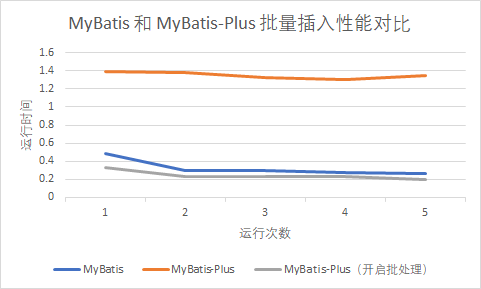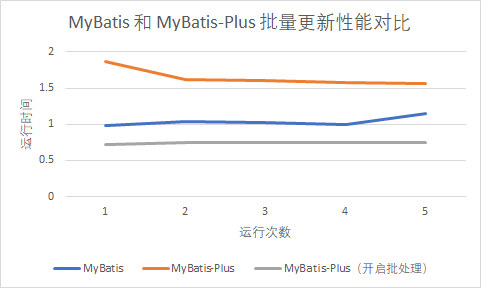demo 地址:learn-mybatis · Sean/spring-cloud-alibaba - 码云(gitee.com)
注意要点:
@GetMapping("/mybatis-batch-insert")
public String mybatisBatchInsert(){
// 开始时间
long stime = System.currentTimeMillis();
// 批量插入
orderService.mySaveBatch(list);
// 结束时间
long etime = System.currentTimeMillis();
return "mybatis 批量插入 1w 条数据的时间: " + (etime - stime) / 1000.0 + "秒";
}
复制@GetMapping("/mybatis-batch-insert")
public String mybatisBatchInsert(){
// 开始时间
long stime = System.currentTimeMillis();
// 批量插入
orderService.mySaveBatch(list);
// 结束时间
long etime = System.currentTimeMillis();
return "mybatis 批量插入 1w 条数据的时间: " + (etime - stime) / 1000.0 + "秒";
}
复制MyBatis 批量更新接口
@GetMapping("/mybatis-batch-update")
public String mybatisBatchUpdate(){
long stime = System.currentTimeMillis();
orderService.myUpdateBatchById(updateList);
long etime = System.currentTimeMillis();
return "mybatis 批量更新 1w 条数据的时间: " + (etime - stime) / 1000.0 + "秒";
}
复制MyBatis 的批量插入是调用 mapper 的批量更新接口,使用
MyBatis-Plus 批量更新接口
@GetMapping("/mybatis-plus-batch-update")
public String mybatisPlusBatchUpdate(){
long stime = System.currentTimeMillis();
orderService.updateBatchById(updateList);
long etime = System.currentTimeMillis();
return "mybatis plus 批量更新 1w 条数据的时间: " + (etime - stime) / 1000.0 + "秒";
}
复制MyBatis -Plus 的批量更新是调用 mybatis-plus 的 IService 接口的 updateBatchById 进行批量更新
经过预热,尽量避免了缓存的影响。

数据量:1w 条数据,每条数据 4 个字段
测试结果:

数据量:1w 条数据,每条数据更新 4 个字段
测试结果:
MyBatis 的批量插入 xml
<insert id="mySaveBatch">
insert into order_table(id, product_id, total_amount, status) values
<foreach collection="list" separator="," item="item">
(#{item.id}, #{item.productId}, #{item.totalAmount}, #{item.status})
</foreach>
</insert>
复制通过
insert into order_table(id, product_id, total_amount, status) values(1, 2. 2.0, 1),(2, 2, 2.0, 1);
复制MyBatis-Plus 的批量插入本质采用 for 遍历每条数据依次插入,但使用了批处理优化,默认是每 1000 条数据,刷新一次 statement 提交到数据库,执行插入操作。
注意:批处理需要在数据库连接中添加 rewriteBatchedStatements=true 否则 jdbc 驱动在默认情况下会无视executeBatch() 语句
源码如下:
@Transactional(rollbackFor = Exception.class) // 开启事务
@Override
public boolean saveBatch(Collection<T> entityList, int batchSize) {
String sqlStatement = getSqlStatement(SqlMethod.INSERT_ONE); // 获得插入 statement
// 执行批处理操作
// 参数是:待插入集合,批次大小(默认1000),函数式接口 accept
return executeBatch(entityList, batchSize, (sqlSession, entity) -> sqlSession.insert(sqlStatement, entity));
}
复制public static <E> boolean executeBatch(Class<?> entityClass, Log log, Collection<E> list, int batchSize, BiConsumer<SqlSession, E> consumer) {
Assert.isFalse(batchSize < 1, "batchSize must not be less than one");
return !CollectionUtils.isEmpty(list) && executeBatch(entityClass, log, sqlSession -> {
int size = list.size();
int idxLimit = Math.min(batchSize, size);
int i = 1;
// 遍历插入
for (E element : list) {
// 调用 sqlSession.insert(sqlStatement, entity));
// 对元素执行插入操作,但此时数据库还没真正执行插入语句
consumer.accept(sqlSession, element);
// 计数达到 1000 或者 集合结束
if (i == idxLimit) {
// 刷新 statement 提交批处理语句,数据库真正执行 SQL
sqlSession.flushStatements();
idxLimit = Math.min(idxLimit + batchSize, size);
}
i++;
}
});
}
复制MyBatis 的批量更新 xml
<update id="myUpdateBatchById">
<foreach collection="list" item="item" index="index" open="" close="" separator=";">
update order_table
<set>
product_id = #{item.productId},
total_amount = #{item.totalAmount},
status = #{item.status}
</set>
where id = #{item.id}
</foreach>
</update>
复制通过
update order_table set product_id = 1, total_amount = 2, status = 1 where id = 1;
update order_table set product_id = 1, total_amount = 2, status = 1 where id = 2;
复制MyBatis-Plus 批量更新的原理基本和其批量插入的原理一致,都是调用 executeBatch 执行批处理操作。
对于批量插入,MyBatis 拼接 SQL 的写法比 MyBatis-Plus 的批量插入方法有明显更高的性能。
但在开启批处理优化之后,MyBatis-Plus 的方法性能更高了。
MyBatis:
MyBatisPlus:
总结:
对于批量更新,MyBatis 拼接 SQL 的写法与 MyBatis-Plus 的批量更新方法无明显的性能差别.
大于大数据量,拼接写法甚至容易出现内存耗尽等问题,相比之下 MyBatis-Plus 的方法更优。
总结:建议使用 MyBatis-Plus